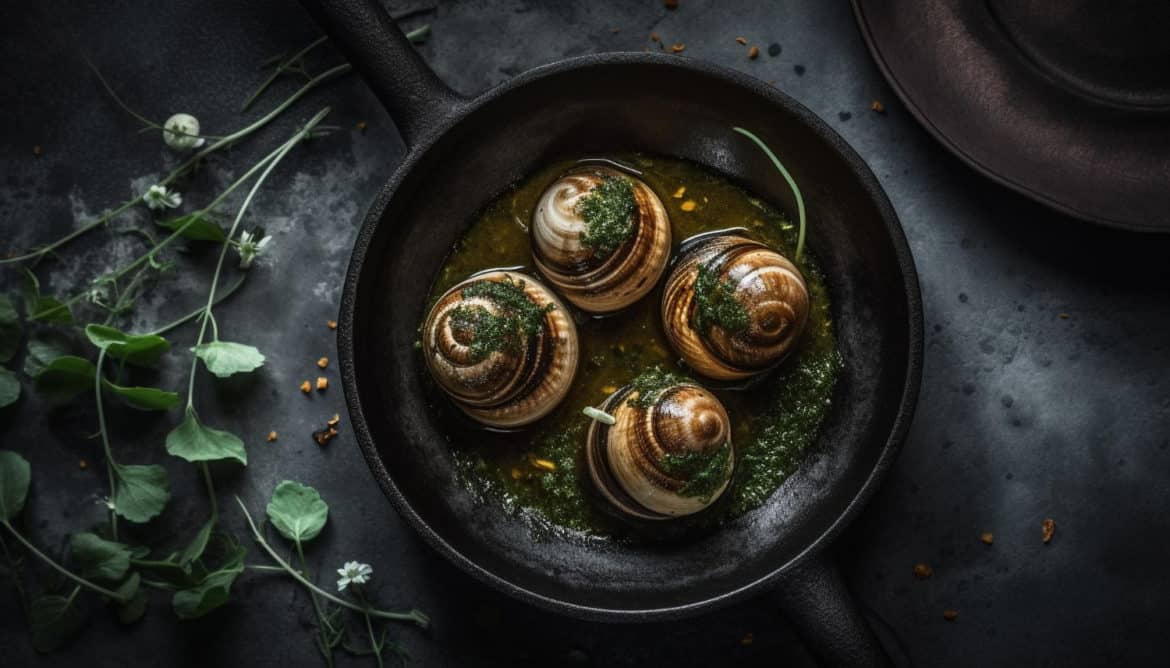If you’re a foodie, you’ve probably heard of escargot. This French delicacy has been around for centuries, but it’s only in recent years that it’s started to make a splash in the food industry. From high-end restaurants to street food vendors, escargot is popping up everywhere.
But what is it about these little snails that’s causing such a stir?
In this blog post, we’ll explore the history of escargot, its nutritional benefits, and how it’s being used in the food and beauty industries. We’ll also provide some simple recipes for cooking escargot at home, so you can try it for yourself!
Escargot: A French Classic Goes Global

Escargot has been a staple of French cuisine for centuries. It was originally considered a food for the poor, but over time it became associated with luxury and sophistication. The first recorded use of snails in cooking dates back to ancient Rome, but it was the French who really embraced the delicacy. In fact, escargot has been a part of French cuisine since the Middle Ages.
Today, escargot is enjoyed all over the world. It’s particularly popular in Europe, but it’s also gaining popularity in Asia and the Americas.
In many countries, escargot is seen as a high-end delicacy, reserved for special occasions or fancy restaurants. But that’s starting to change, as more and more people discover the joys of escargot.
The Nutritional Benefits of Escargot
Escargot may not be the first thing that comes to mind when you think of healthy foods, but it’s actually quite nutritious. Snails are a good source of protein, and they’re low in fat and calories. They’re also high in vitamins and minerals, including iron, magnesium, and calcium.
The Escargot Farming Process
If you’re wondering where all these escargot are coming from, the answer is simple: they’re farmed. Escargot farming is a relatively new industry, but it’s growing quickly. The process involves raising snails in a controlled environment, where they’re fed a diet of grains and vegetables. The snails are then harvested and processed for use in food and beauty products.
Farming escargot has a number of benefits over hunting for wild snails. For one thing, it’s more sustainable. Wild snails are often over-harvested, which can lead to declines in their populations. Farming escargot ensures a steady supply of snails without depleting wild populations. It’s also more hygienic, as farmed snails are raised in a clean environment and are free from parasites and other contaminants.
Escargot in the Restaurant Industry

Escargot has been a staple of high-end French restaurants, especially in the East of the country, but it’s now being used in a variety of cuisines. In many restaurants, escargot is served as an appetizer, often with garlic butter or other flavorful sauces. It’s also used as a topping for pizzas and pastas, and as a filling for savory pastries.
One of the great things about escargot is its versatility. It can be used in a variety of dishes, from classic French recipes to modern fusion cuisine. And because it has a mild flavor, it pairs well with a wide range of ingredients.
Curious about the perfect pairings for escargot?
Here’s a quick list of ingredients that complement its flavor profile and elevate the culinary experience:
- Garlic: A classic combination, garlic adds a rich, pungent flavor that complements the mild taste of escargot.
- Butter: Escargot is often cooked in butter, which adds richness and enhances its natural flavors.
- Parsley: Fresh parsley provides a bright, herbal note that balances the richness of escargot.
- Shallots: Shallots have a milder, sweeter flavor compared to onions, making them a great choice for enhancing the taste of escargot.
- Lemon: A squeeze of lemon juice or a zest can add a refreshing, citrusy element to the dish.
- White wine: A dry white wine, such as Chardonnay or Sauvignon Blanc, can be used to deglaze the pan or create a flavorful sauce.
- Herbs (such as thyme or tarragon): Adding herbs to the dish can elevate the overall flavor profile and add complexity.
- Pernod or Pastis: An anise-flavored liqueur, Pernod or Pastis can provide a distinct and aromatic note to the dish.
- Bread or pastry: Serving escargot with crusty bread or puff pastry allows you to soak up the delicious butter and herb-infused sauce.
- Mushrooms: Sautéed mushrooms can complement the earthy flavor of escargot and add another layer of texture.
The Escargot Trend in Street Food
Escargot may be a high-end delicacy, but it’s also being used in street food. In recent years, a number of food trucks and street vendors have started serving escargot dishes. These dishes are often more affordable than those served in restaurants, making escargot more accessible to a wider range of people.
Some popular street food dishes that feature escargot include escargot tacos, escargot sliders, and escargot kebabs. These dishes are often served with spicy sauces and other flavorful toppings, giving them a unique and delicious flavor.
Escargot in the Beauty Industry

Escargot isn’t just for eating – it’s also being used in the beauty industry. Specifically, escargot slime is being used in a variety of beauty products.
The slime contains a number of beneficial compounds, including allantoin, collagen, and elastin. These compounds have been shown to have a number of benefits for the skin, including reducing inflammation, improving hydration, and increasing elasticity.
Some popular beauty products that use escargot slime include face creams, serums, and masks. These products are often marketed as anti-aging treatments, and they’re popular with people who want to improve the appearance of their skin.
The Future of Escargot in the Food Industry

The escargot industry is still relatively small, but it’s growing quickly. As more people discover the joys of escargot, demand is likely to increase. This could lead to new innovations in the field, such as new farming techniques and new ways of preparing and serving escargot.
One trend that’s likely to continue is the use of escargot in street food, like mentioned. This trend has been growing in recent years, and it shows no signs of slowing down. As more food trucks and street vendors start serving escargot dishes, it’s likely to become even more popular with the general public.
Escargot Recipes to Try at Home
If you’re curious about escargot but don’t want to go to a fancy restaurant to try it, there are plenty of recipes you can try at home. Here are a few simple recipes to get you started:
Garlic Butter Escargot
Ingredients:
1 can of escargot
4 cloves of garlic, minced
1/2 cup of butter
1 tbsp of parsley, chopped
Salt and pepper to taste
Instructions:
- Preheat your oven to 350 degrees F.
- Drain the escargot and rinse them under cold water.
- In a small saucepan, melt the butter over medium heat.
- Add the garlic and cook for 2-3 minutes, until fragrant.
- Add the escargot to the saucepan and toss to coat.
- Transfer the escargot to a baking dish and bake for 10-15 minutes, until heated through.
- Sprinkle with parsley and serve.
Escargot Pizza
Ingredients:
1 pre-made pizza crust
1/2 cup of tomato sauce
1 cup of shredded mozzarella cheese
1 can of escargot
1/2 cup of sliced mushrooms
1/4 cup of sliced black olives
Salt and pepper to taste
Instructions:
- Preheat your oven to 425 degrees F.
- Spread the tomato sauce over the pizza crust.
- Sprinkle the cheese over the tomato sauce.
- Drain the escargot and rinse them under cold water.
- Arrange the escargot, mushrooms, and black olives on top of the cheese.
- Sprinkle with salt and pepper.
- Bake for 10-15 minutes, until the cheese is melted and bubbly.
- Slice and serve.
Escargot Salad
Ingredients:
1 can of escargot
4 cups of mixed greens
1/4 cup of cherry tomatoes, halved
1/4 cup of sliced cucumbers
1/4 cup of sliced red onions
1/4 cup of crumbled feta cheese
1/4 cup of balsamic vinaigrette
Instructions:
- Drain the escargot and rinse them under cold water.
- In a large bowl, combine the mixed greens, cherry tomatoes, cucumbers, and red onions.
- Add the escargot to the bowl and toss to combine.
- Sprinkle with feta cheese.
- Drizzle with balsamic vinaigrette and serve.
Conclusion
Escargot may not be for everyone, but it’s definitely worth trying. Whether you’re a foodie looking for new flavors to explore, or a beauty enthusiast looking for new ways to improve your skin, escargot has something to offer. And with the escargot industry on the rise, there’s never been a better time to give it a try. So why not whip up one of these recipes and see what all the fuss is about? You might just discover your new favorite food.
If you liked this post make sure to check our other post called “Weird French Dishes and Where to Get Them” featuring more interesting and unusual French foods. Or, if you want to keep learning about escargot, check our article “What Do French People Eat? Escargot Is The One!“.

